Toshiba B-SA4TM, EO1-33047 User Manual
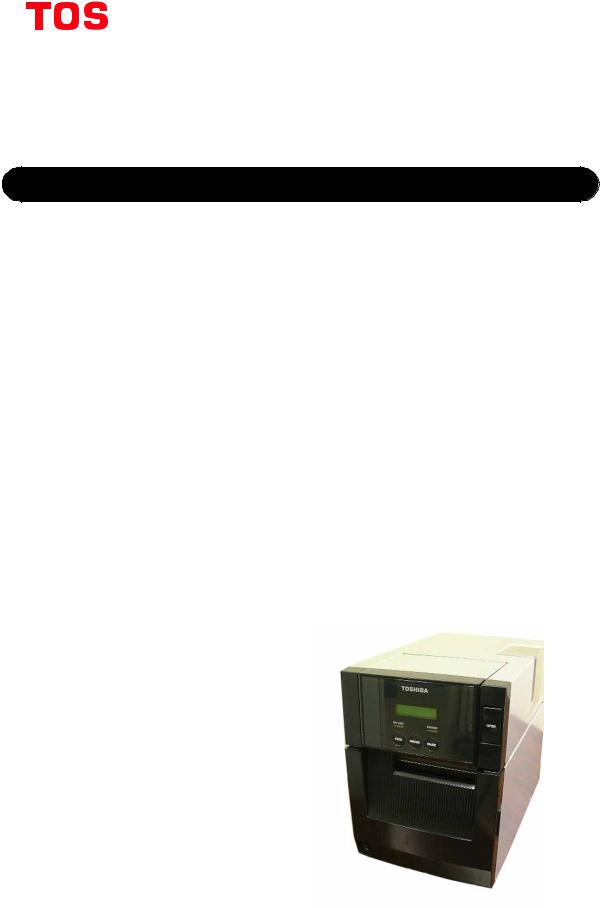
#
#
TOSHIBA Thermal Printer
B-SA4TM SERIES
Owner’s Manual
#
#
#
#
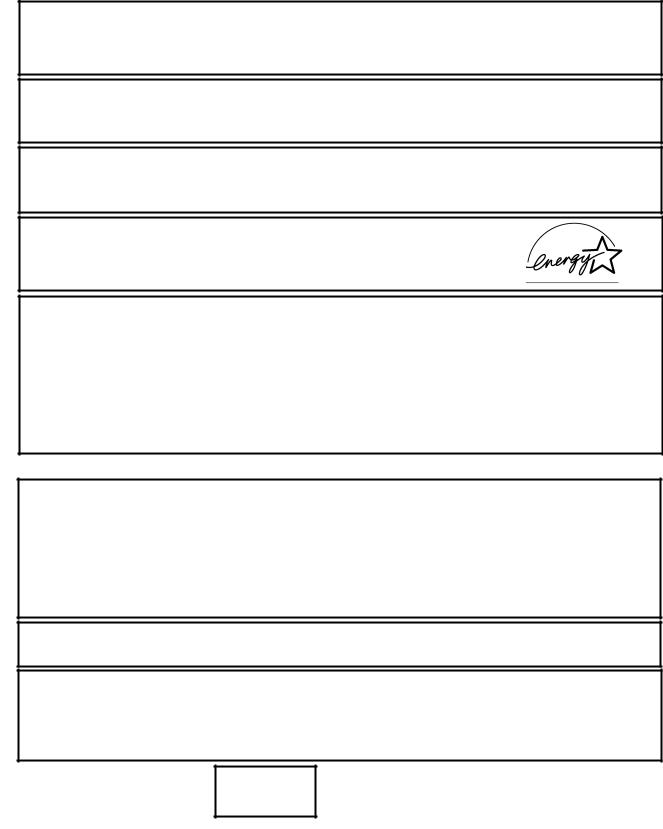
CE Compliance (for EU only) |
|
# This product complies with the requirements of EMC and Low Voltage Directives including their |
|
amendments. |
# |
VORSICHT:
∙Schallemission: unter 70dB (A) nach DIN 45635 (oder ISO 7779)
∙Die für das Gerät Vorgesehene Steckdose muß in der Nähe des Gerätes und leicht zugänglich sein.
Centronics is a registered trademark of Centronics Data Computer Corp.
Microsoft is a registered trademark of Microsoft Corporation.
Windows is a trademark of Microsoft Corporation.
As an ENERGY STAR® Partner, TOSHIBA TEC has determined that this
product meets the ENERGY STAR® guidelines for energy efficiency.#
#
-- Outline of the International ENERGY STAR® Office Equipment Program --
The International ENERGY STAR® Office Equipment Program is an international program that promotes energy saving through the penetration of energy efficient computers and other office equipment. The program backs the development and dissemination of products with functions that effectively reduce energy consumption. It is an open system in which business proprietors can participate voluntarily. The targeted products are office equipment such as computers, monitors, printers, facsimiles, copiers, scanners, and multifunction devices. Their standards and logos are uniform among participating nations.#
ENERGY STAR is a U.S. registered mark.#
This equipment has been tested and found to comply with the limits for a Class A digital device, pursuant to Part 15 of the FCC Rules. These limits are designed to provide reasonable rotection against harmful interference when the equipment is operated in a commercial environment. This equipment generates, uses, and can radiate radio frequency energy and, if not installed and sed in accordance with the instruction manual, may cause harmful interference to radio communications. Operations of this equipment in a residential area is likely to cause harmful interference in which case the user will be required to correct the interference at his own expense.
(for USA only)
Changes or modifications not expressly approved by manufacturer for compliance could void the user’s authority to operate the equipment.#
“This Class A digital apparatus meets all requirements of the Canadian Interference-Causing Equipment Regulations.”
“Cet appareil numérique de la classe A respecte toutes les exigences du Règlement sur le matériel brouilleur du Canada.”
(for CANADA only)
N258 IP20
< For EU Only > |
Copyright © 2005 |
|
by TOSHIBA TEC CORPORATION |
||
TOSHIBA TEC Europe Retail Information Systems S.A. |
||
All Rights Reserved |
||
Rue de la Célidée 33 BE-1080 Brussels |
570 Ohito, Izunokuni-shi, Shizuoka-ken, JAPAN# |

#
#
TOSHIBA Thermal Printer
B-SA4TM SERIES
#
 Owner's Manual
Owner's Manual
#

#
Waste Recycling information for users:
Following information is only for EU-member states:
The use of the crossed-out wheeled bin symbol indicates that this product may not be treated as general household waste.
By ensuring this product is disposed of correctly you will help prevent
potential negative consequences for the environment and human health, which could otherwise be caused by inappropriate waste handling of this product. For more detailed information about the take-back and recycling of this product, please contact your supplier where you purchased the product.
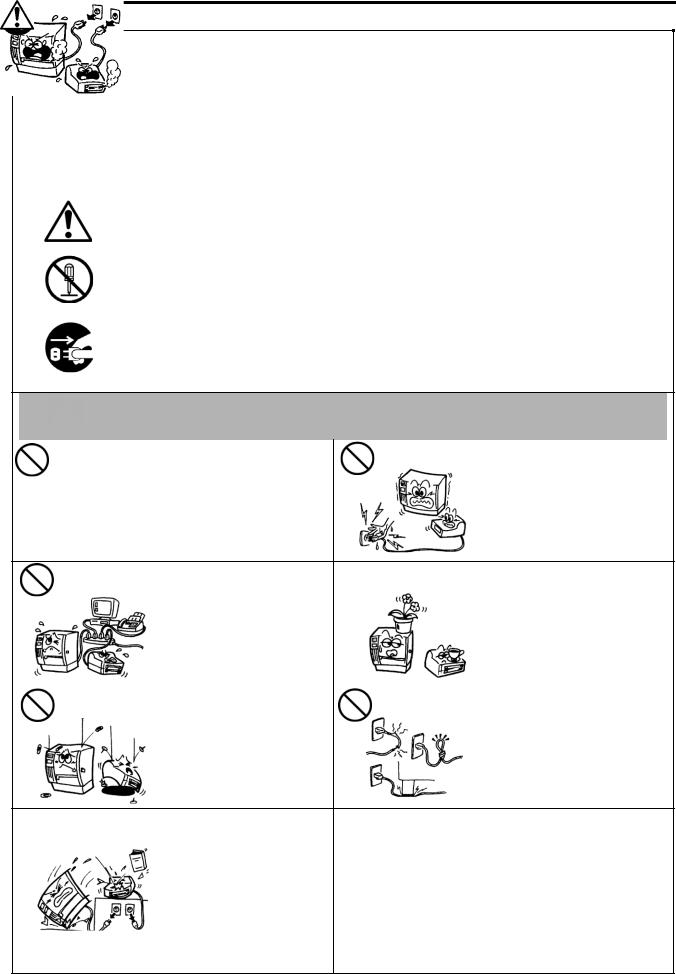
Safety Summary |
ENGLISH VERSION EO1-33047 |
Safety Summary
Personal safety in handling or maintaining the equipment is extremely important. Warnings and Cautions necessary for safe handling are included in this manual. All warnings and cautions contained in this manual
should be read and understood before handling or maintaining the equipment.
Do not attempt to effect repairs or modifications to this equipment. If a fault occurs that cannot be rectified using the procedures described in this manual, turn off the power, unplug the machine, then contact your authorised TOSHIBA TEC representative for assistance.
Meanings of Each Symbol
This symbol indicates warning items (including cautions).
Specific warning contents are drawn inside the  symbol. (The symbol on the left indicates a general caution.)
symbol. (The symbol on the left indicates a general caution.)
This symbol indicates prohibited actions (prohibited items).
Specific prohibited contents are drawn inside or near the  symbol. (The symbol on the left indicates “no disassembling”.)
symbol. (The symbol on the left indicates “no disassembling”.)
This symbol indicates actions which must be performed.
Specific instructions are drawn inside or near the z symbol.
(The symbol on the left indicates “disconnect the power cord plug from the outlet”.)
|
|
|
WARNING |
This indicates that there is the risk of death or serious injury if the |
|
|||
|
|
|
|
|||||
|
|
|
machines are improperly handled contrary to this indication. |
|
||||
|
|
|
|
|
|
|
|
|
|
|
Any other than the |
Do not use voltages other than |
Prohibited |
Do not plug in or unplug the power |
|||
|
|
specified AC voltage the voltage (AC) specified on the |
cord plug with wet hands as this |
|||||
|
|
is prohibited. |
rating plate, as this may cause |
|
may cause electric shock. |
|||
|
|
|
|
|
||||
|
|
|
|
fire or electric shock. |
|
|
|
|
|
|
|
|
|
|
|
|
|
Prohibited |
If the machines share the same |
|
Prohibited |
Do not place metal objects or |
|
||||
outlet with any other electrical |
|
water-filled containers such as |
||
|
appliances that consume large |
|
|
flower vases, flower pots or mugs, |
|
|
|
||
|
amounts of power, the voltage |
|
|
etc. on top of the machines. If |
|
will fluctuate widely each time |
|
|
metal objects or spilled liquid enter |
|
these appliances operate. Be sure |
|
|
the machines, this may cause fire |
|
to provide an exclusive outlet for |
|
|
or electric shock. |
|
the machine as this may cause |
|
|
|
|
fire or electric shock. |
|
|
|
Prohibited |
Do not insert or drop metal, |
|
Prohibited |
Do not scratch, damage or modify |
flammable or other foreign |
|
the power cords. Also, do not |
||
|
objects into the machines through |
|
|
place heavy objects on, pull on, or |
|
the ventilation slits, as this may |
|
|
excessively bend the cords, as this |
|
cause fire or electric shock. |
|
|
may cause fire or electrical shock. |
|
Disconnect |
If the machines are dropped or |
|
Disconnect |
Continued use of the machines in |
|
|
||||
|
|
||||
|
their cabinets damaged, first turn |
|
an abnormal condition such as |
||
|
the plug. |
|
the plug. |
||
|
|
off the power switches and |
|
|
when the machines are producing |
|
|
disconnect the power cord plugs |
|
|
smoke or strange smells may cause |
|
|
from the outlet, and then contact |
|
|
fire or electric shock. In these |
|
|
your authorised TOSHIBA TEC |
|
|
cases, immediately turn off the |
|
|
representative for assistance. |
|
|
power switches and disconnect the |
|
|
Continued use of the machine in |
|
|
power cord plugs from the outlet. |
|
|
that condition may cause fire or |
|
|
Then, contact your authorised |
|
|
electric shock. |
|
|
TOSHIBA TEC representative for |
|
|
|
|
|
assistance. |
( i )
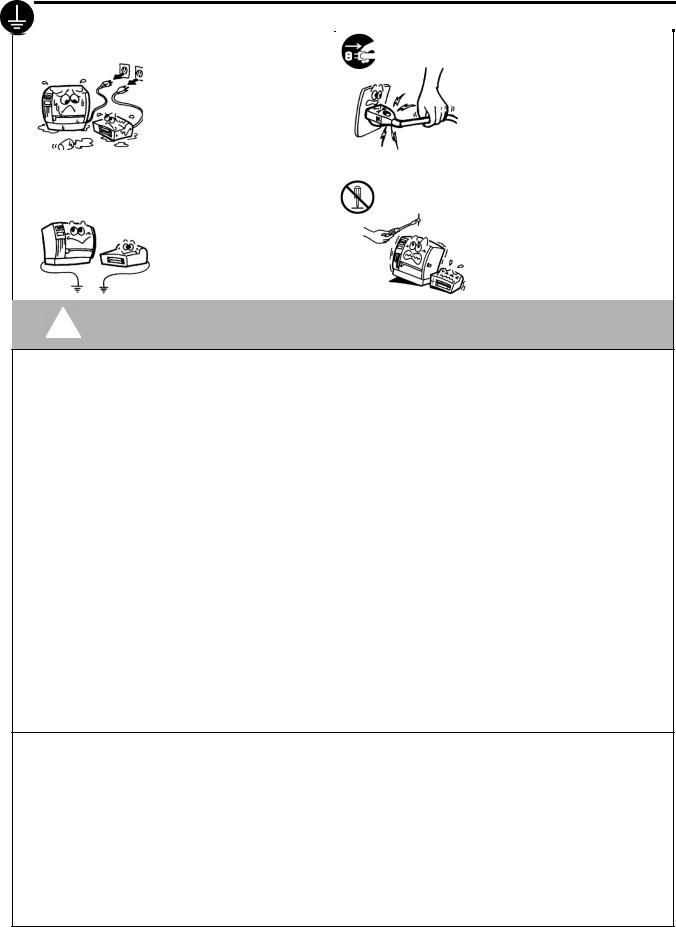
Safety Summary |
ENGLISH VERSION EO1-33047 |
|
|
Disconnect |
If foreign objects (metal |
Disconnect |
When unplugging the power cords, |
|
|
||||
|
|
fragments, water, liquids) enter |
be sure to hold and pull on the plug |
||
|
|
the plug. |
the machines, first turn off the |
the plug. |
portion. Pulling on the cord portion |
|
|
|
power switches and disconnect |
|
may cut or expose the internal wires |
|
|
|
the power cord plugs from the |
|
and cause fire or electric shock. |
|
|
|
outlet, and then contact your |
|
|
|
|
|
authorised TOSHIBA TEC |
|
|
|
|
|
representative for assistance. |
|
|
|
|
|
Continued use of the machine in |
|
|
|
|
|
that condition may cause fire or |
|
|
|
|
|
electric shock. |
|
|
|
|
Connect a |
Ensure that the equipment is |
No |
Do not remove covers, repair or |
|
|
properly grounded. Extension |
modify the machine by yourself. |
||
|
|
grounding wire. |
disassembling. |
||
|
|
|
cables should also be grounded. |
|
You may be injured by high |
|
|
|
Fire or electric shock could |
|
voltage, very hot parts or sharp |
|
|
|
occur on improperly grounded |
|
edges inside the machine. |
|
|
|
equipment. |
|
|
|
|
|
|
|
|
CAUTION This indicates that there is the risk of personal Injury or damage to objects if the machines are improperly handled contrary to this indication.
Precautions
The following precautions will help to ensure that this machine will continue to function correctly.
• Try to avoid locations that have the following adverse conditions: |
* |
High humidity |
|||
* |
Temperatures out of the specification |
* |
Direct sunlight |
||
* |
Shared power source |
* |
Excessive vibration |
* |
Dust/Gas |
•The cover should be cleaned by wiping with a dry cloth or a cloth slightly dampened with a mild detergent solution. NEVER USE THINNER OR ANY OTHER VOLATILE SOLVENT on the plastic covers.
•USE ONLY TOSHIBA TEC SPECIFIED paper and ribbons.
•DO NOT STORE the paper or ribbons where they might be exposed to direct sunlight, high temperatures, high humidity, dust, or gas.
•Ensure the printer is operated on a level surface.
•Any data stored in the memory of the printer could be lost during a printer fault.
•Try to avoid using this equipment on the same power supply as high voltage equipment or equipment likely to cause mains interference.
•Unplug the machine whenever you are working inside it or cleaning it.
•Keep your work environment static free.
•Do not place heavy objects on top of the machines, as these items may become unbalanced and fall causing injury.
•Do not block the ventilation slits of the machines, as this will cause heat to build up inside the machines and may cause fire.
•Do not lean against the machine. It may fall on you and could cause injury.
•Care must be taken not to injure yourself with the printer paper cutter.
•Unplug the machine when it is not used for a long period of time.
•Place the machine on a stable and level surface.
Request Regarding Maintenance
•Utilize our maintenance services.
After purchasing the machine, contact your authorised TOSHIBA TEC representative for assistance once a year to have the inside of the machine cleaned. Otherwise, dust will build up inside the machines and may cause a fire or a malfunction. Cleaning is particularly effective before humid rainy seasons.
•Our preventive maintenance service performs the periodic checks and other work required to maintain the quality and performance of the machines, preventing accidents beforehand.
For details, please consult your authorised TOSHIBA TEC representative for assistance.
•Using insecticides and other chemicals
Do not expose the machines to insecticides or other volatile solvents. This will cause the cabinet or other parts to deteriorate or cause the paint to peel.
(ii)
ENGLISH VERSION EO1-33047
|
|
|
TABLE OF CONTENTS |
|
|
|
|
|
Page |
1. |
PRODUCT OVERVIEW......................................................................................................... |
E1- 1 |
||
|
1.1 |
Introduction................................................................................................................... |
E1- 1 |
|
|
1.2 |
Features ....................................................................................................................... |
E1- 1 |
|
|
1.3 |
Accessories ................................................................................................................. |
E1- 2 |
|
|
1.4 |
Appearance .................................................................................................................. |
E1- 3 |
|
|
|
1.4.1 |
Dimensions................................................................................................................ |
E1- 3 |
|
|
1.4.2 |
Front View ................................................................................................................. |
E1- 3 |
|
|
1.4.3 Rear View.................................................................................................................. |
E1- 3 |
|
|
|
1.4.4 |
Operation Panel......................................................................................................... |
E1- 4 |
|
|
1.4.5 |
Interior ....................................................................................................................... |
E1- 4 |
|
1.5 |
Options ................................................................................................................................ |
E1- 5 |
|
2. |
PRINTER SETUP .................................................................................................................. |
E2- 1 |
||
|
2.1 |
Installation .................................................................................................................... |
E2- 2 |
|
|
|
2.1.1 |
Attaching the Printer Rear Support............................................................................ |
E2- 2 |
|
2.2 |
Connecting the Power Cord ......................................................................................... |
E2- 2 |
|
|
2.3 |
Loading the Media ........................................................................................................ |
E2- 3 |
|
|
2.4 |
Loading the Ribbon ..................................................................................................... |
E2-11 |
|
|
2.5 |
Connecting the Printer to Your Host Computer ........................................................... |
E2-14 |
|
|
2.6 |
Turning the Printer ON ................................................................................................ |
E2-15 |
|
|
2.7 |
Setting an Operating Environment .............................................................................. |
E2-16 |
|
|
|
2.7.1 How to Enter the System Mode................................................................................ |
E2-17 |
|
|
|
2.7.2 |
Parameter Setting..................................................................................................... |
E2-17 |
|
|
2.7.3 |
IP Address Setting (TCP/IP)..................................................................................... |
E2-24 |
|
2.8 |
Installing the Printer Drivers ........................................................................................ |
E2-30 |
|
|
|
2.8.1 |
Introduction............................................................................................................... |
E2-30 |
|
|
2.8.2 |
General Description.................................................................................................. |
E2-30 |
|
|
2.8.3 |
Installing the Printer Driver ....................................................................................... |
E2-31 |
|
|
2.8.4 |
Uninstalling the Printer Driver................................................................................... |
E2-43 |
|
|
2.8.5 |
Adding/Deleting a LAN Port...................................................................................... |
E2-44 |
|
|
2.8.6 |
Cautions ................................................................................................................... |
E2-46 |
|
|
2.8.7 |
Using the Printer Driver ............................................................................................ |
E2-47 |
|
2.9 |
Print Test ..................................................................................................................... |
E2-48 |
|
|
2.10 Position and Print Tone Fine Adjustment ................................................................... |
E2-50 |
||
|
2.11 |
Threshold Setting ........................................................................................................ |
E2-59 |
|
3. |
ON LINE OPERATION.......................................................................................................... |
E3- 1 |
||
|
3.1 |
Operation Panel............................................................................................................ |
E3- 1 |
|
|
3.2 |
Operation...................................................................................................................... |
E3- 2 |
|
|
3.3 |
Reset |
............................................................................................................................ |
E3- 2 |
4. |
MAINTENANCE .................................................................................................................... |
E4- 1 |
||
|
4.1 |
Cleaning ....................................................................................................................... |
E4- 1 |
|
|
|
4.1.1 |
Print Head/Platen/Sensors ........................................................................................ |
E4- 1 |
|
|
4.1.2 |
Covers and Panels .................................................................................................... |
E4- 2 |
|
|
4.1.3 |
Optional Cutter Module.............................................................................................. |
E4- 3 |
|
|
4.1.4 |
Optional Strip Module ................................................................................................ |
E4- 4 |

ENGLISH VERSION EO1-33047#
5. |
TROUBLESHOOTING......................................................................................................... |
E5- 1 |
||
|
5.1 |
Error Messages........................................................................................................... |
E5- 1 |
|
|
5.2 |
Possible Problems ...................................................................................................... |
E5- 3 |
|
|
5.3 |
Removing Jammed Media........................................................................................... |
E5- 4 |
|
6. |
PRINTER SPECIFICATIONS............................................................................................... |
E6- 1 |
||
7. |
SUPPLY SPECIFICATIONS ................................................................................................ |
E7- 1 |
||
|
7.1 |
Media |
.......................................................................................................................... |
E7- 1 |
|
|
7.1.1 Media Type ....................................................................................................... |
E7- 1 |
|
|
|
7.1.2 |
Detection Area of the Transmissive Sensor....................................................... |
E7- 2 |
|
|
7.1.3 |
Detection Area of the Reflective Sensor ............................................................ |
E7- 3 |
|
|
7.1.4 |
Effective Print Area............................................................................................ |
E7- 3 |
|
7.2 |
Ribbon ........................................................................................................................ |
E7- 4 |
|
|
7.3 |
Recommended Media and Ribbon Types ................................................................... |
E7- 4 |
|
|
7.4 |
Care/Handling of Media and Ribbon............................................................................ |
E7- 5 |
|
APPENDIX 1 MESSAGES AND LEDS.................................................................................... |
EA1-1 |
|||
APPENDIX 2 INTERFACE ...................................................................................................... |
EA2-1 |
|||
APPENDIX 3 POWER CORD.................................................................................................. |
EA3-1 |
|||
APPENDIX 4 PRINT SAMPLES .............................................................................................. |
EA4-1 |
|||
APPENDIX 5##GLOSSARIES.................................................................................................... |
EA5-1 |
|||
INDEX |
|
|
|
|
WARNING!
This is a Class A product. In a domestic environment this product may cause radio interference in which case the user may be required to take adequate measures.
CAUTION!
1.This manual may not be copied in whole or in part without prior written permission of TOSHIBA TEC.
2.The contents of this manual may be changed without notification.
3.Please refer to your local Authorised Service representative with regard to any queries you may have in this manual.

1. PRODUCT OVERVIEW |
ENGLISH VERSION EO1-33047 |
1.1 Introduction
1. PRODUCT OVERVIEW
1.1 Introduction
7KDQN#\RX#IRU#FKRRVLQJ#WKH#726+,%$#%06$770#VHULHV#WKHUPDO#SULQWHU1## 7KLV# 2ZQHU¶V# 0DQXDO# FRQWDLQV# IURP# JHQHUDO# VHW0XS# WKURXJK# KRZ# WR# FRQILUP# WKH# SULQWHU# RSHUDWLRQ# XVLQJ# DQ# RQOLQH# WHVW# SULQW/# DQG# VKRXOG# EH# UHDG# FDUHIXOO\# WR# KHOS# JDLQ# PD[LPXP# SHUIRUPDQFH# DQG# OLIH# IURP# \RXU# SULQWHU1##)RU#PRVW#TXHULHV#SOHDVH#UHIHU#WR#WKLV#PDQXDO#DQG#NHHS#LW#VDIH#IRU# IXWXUH#UHIHUHQFH1##3OHDVH#FRQWDFW#\RXU#726+,%$#7(UHSUHVHQWDWLYH#IRU# IXUWKHU#LQIRUPDWLRQ#FRQFHUQLQJ#WKLV#PDQXDO1#
#
#
1.2 Features
7KLV#SULQWHU#KDV#WKH#IROORZLQJ#IHDWXUHV=#
∙ Space-saving design
$Q# DUHD# UHTXLUHG# WR# SODFH# D# SULQWHU# LV# DERXW# $7# VL]H/# LQ# VSLWH# RI# ERWK# PHGLD#DQG#ULEERQ#EHLQJ#ORDGHG#LQVLGH#LW1##$OVR/#WKH#7RS#&RYHU#LV#RSHQHG# XSZDUG/#ZKLFK#VDYHV#WKH#LQVWDOODWLRQ#VSDFH1##
7KH# RSWLRQDO# FXWWHU# PRGXOH# DQG# VWULS# PRGXOH# DUH# DV# VOLP# DQG# VPDOO# DV# WKH#)URQW#&RYHU1#
#
∙ Various kinds of interface
9DULRXV#NLQGV#RI#LQWHUIDFH#DUH#SURYLGHG=#
?6WDQGDUG!# |
?2SWLRQ!# |
∙ 3DUDOOHO# |
∙#6HULDO# |
∙ 86%# |
∙#:LUHOHVV#/$1# |
∙ %XLOW0LQ#/$1# |
∙#5),'# |
#
∙Superior hardware
&OHDU#SULQW#LV#UHDOL]HG#E\#DQ#;#GRWV2PP#+536#GSL,#+%06$7700*645,#RU# 441;# GRWV2PP# +633# GSL,# +%06$77007645,# SULQW# KHDG/# DW# D# SULQWLQJ# VSHHG#RI#831;#PP2VHF1#+5#LQFKHV2VHF1,/#43419#PP2VHF1#+7#LQFKHV2VHF1,/#RU# 48517#PP2VHF1#+9#LQFKHV2VHF1,#
#
∙Heavy-duty enclosure
$V# WKH# HQFORVXUH# LV# PDGH# RI# PHWDO/# WKH# SULQWHU# FDQ# EH# XVHG# LQ# DQ# LQGXVWULDO#HQYLURQPHQW#VXFK#DV#D#IDFWRU\1#
#
∙Easy maintenance
'HVLJQ#RI#WKH#SULQWHU#LV#VLPSOH1##(VSHFLDOO\/#DWWDFKPHQW#DQG#UHPRYDO#RI# WKH# SULQW# KHDG# DQG# SODWHQ# DUH# YHU\# VLPSOH/# ZKLFK# PDNHV# PDLQWHQDQFH# HDV\1###
#
∙A variety of options
7KH#IROORZLQJ#RSWLRQDO#GHYLFHV#DUH#DYDLODEOH=#
∙&XWWHU#PRGXOH#
∙6WULS#PRGXOH#
∙6HULDO#LQWHUIDFH#ERDUG#
∙:LUHOHVV#/$1#ERDUG#
∙5),'#PRGXOH#
∙6330GSL#SULQW#KHDG#
#
E1- 1
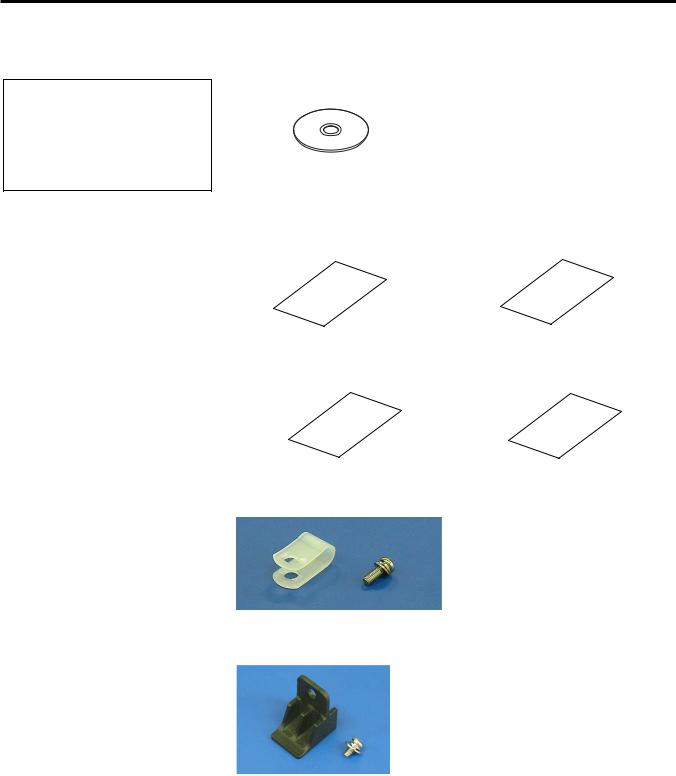
1. PRODUCT OVERVIEW
ENGLISH VERSION EO1-33047
1.3 Accessories
1.3Accessories
NOTE:
As a power cord is not supplied with this printer, please purchase one that meets each country’s safety standard. For details, refer to APPENDIX 3.
When unpacking the printer, please make sure all the following accessories are supplied with the printer.
Start-up CD-ROM (1 pc.)
<Contents>
•Bar code print application (Bartender ultra lite)
•Windows Driver
•Owner’s Manual
•Specifications (Programming, Key operation, etc.)
•Product information (Catalogue)
Supply Loading Instructions |
Safety Precautions |
(Doc. No.: EO2-33015) |
(Doc. No.: EO2-33016) |
Quality Control Report |
Warranty Disclaimer Sheet |
(1 sheet) |
(1 sheet) |
Cable Clamp (1 pc.)
SMW-3x8 Screw (1 pc.)
Printer Rear Support (1 pc.)
SMW-4x8 Screw (1 pc.)
E1- 2
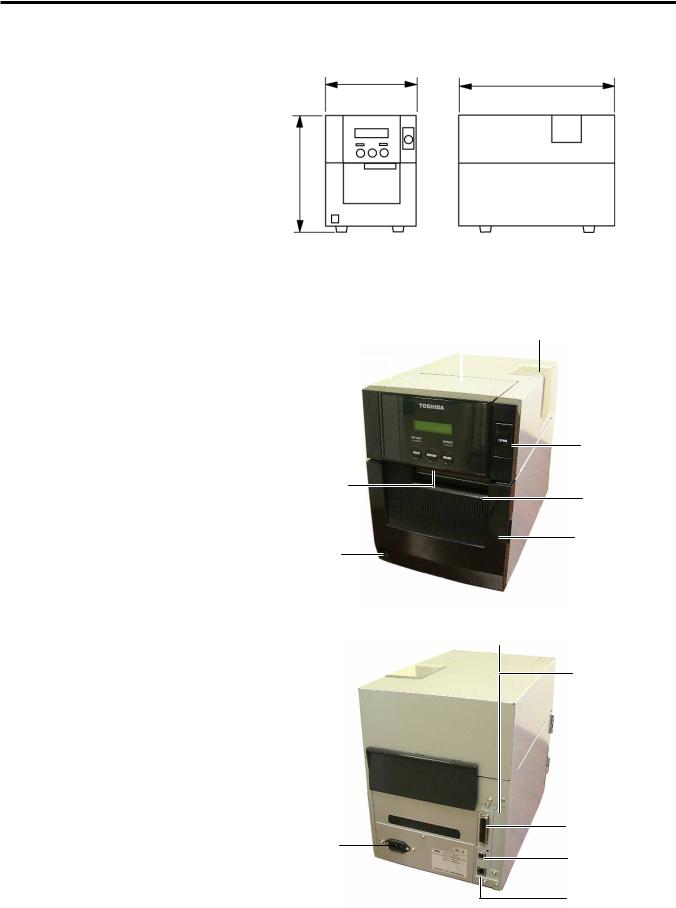
1. PRODUCT OVERVIEW |
ENGLISH VERSION EO1-33047 |
1.4 Appearance
1.4 Appearance
1.4.1 Dimensions
1.4.2 Front View
1.4.3 Rear View#
#
#
#
7KH#QDPHV#RI#WKH#SDUWV#RU#XQLWV#LQWURGXFHG#LQ#WKLV#VHFWLRQ#DUH#XVHG#LQ#WKH# |
||
IROORZLQJ#FKDSWHUV1# |
|
|
# |
238 (9.4) |
401.7 (15.8) |
|
||
331.5
(13.1)
# |
|
|
|
|
# |
|
|
|
|
# |
|
|
|
|
# |
|
|
|
|
# |
Ribbon Cover |
|
|
|
# |
|
|
||
|
|
|
|
|
|
Top Cover |
|
|
|
|
|
|
|
|
|
|
|
|
|
|
|
|
|
|
LCD Message 
Display
Operation Panel
Power Switch
O: OFF
I: ON
#
#
#
AC Power Inlet
#
#
#
'LPHQVLRQV#LQ#PP#+LQFKHV,#
 Supply Window
Supply Window
Top Cover
Release Button
Media Outlet
Front Cover
#
 RS-232C Serial Interface Connector (Option)
RS-232C Serial Interface Connector (Option)
Wireless LAN Interface Board (Option)
Parallel Interface Connector (Centronics)
USB Interface
Connector
#LAN Interface
Connector
E1- 3
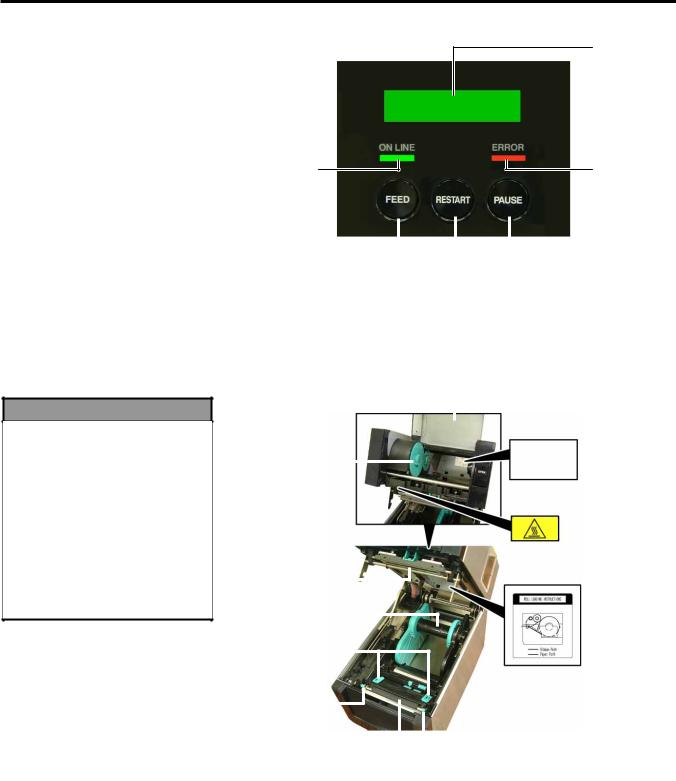
1. PRODUCT OVERVIEW |
ENGLISH VERSION EO1-33047 |
1.4 Appearance
1.4.4 Operation Panel
LCD Message
Display
ON LINE LED |
ERROR LED |
(Green) |
(Red) |
1.4.5 Interior
WARNING!
1.Do not touch the Print Head or around it just after printing. You may get burned as the Print Head becomes very hot during printing.
2.Do not open the Ribbon Cover during printing. Your fingers, hair, clothing, etc. may be drawn into the moving parts.
# |
|
|
|
|
|
|
|
|
|
|
|
|
|
|
|
|
|
|
|
|
|
|
|
# |
|
|
|
|
|
|
|
|
|
|
|
|
|
|
|
|
|
|
|
|
|
|
|
|
|
|
|
[PAUSE] key |
|
#[FEED] key |
|
|
|
|
|
|
|
|
|
|
|
|
|
|
|
|
|
|
|
|
|
|
|
|||
|
|
|
|
|
|
|
|
|
|
|
|
|
|
|
|
|
|
|
|
|
|
|
||||
# |
|
|
|
|
|
|
|
|
|
|
|
|
|
|
|
|
|
|
|
|
|
|
|
|
|
[RESTART] key |
# |
|
|
|
|
|
|
|
|
|
|
|
|
|
|
|
|
|
|
|
|
|
|
|
|
|
|
|
|
|
|
|
|
|
|
|
|
|
|
|
|
|
|
|
|
|
|
|
|
|
|
|
|
|
3OHDVH#VHH#6HFWLRQ#614#IRU#IXUWKHU#LQIRUPDWLRQ#DERXW#WKH#2SHUDWLRQ#3DQHO1## |
||||||||||||||||||||||||||
# |
|
|
|
|
|
|
|
|
|
|
|
|
|
|
|
|
|
|
|
|
|
|
|
|
|
|
# |
|
|
|
|
|
|
|
|
|
|
|
|
|
|
|
|
|
|
|
|
|
|
|
|
|
|
# |
|
|
|
|
|
|
|
|
|
|
|
|
|
|
|
|
|
|
|
|
|
|
|
|
|
|
# |
|
|
|
|
|
|
|
|
|
|
|
|
|
|
|
|
|
|
|
|
|
|
|
|
|
|
# |
Ribbon Cover |
|
|
|
|
|
|
|
|
|
|
|
|
|
|
|
|
|
||||||||
# |
|
|
|
|
|
|
|
|
|
|
|
|
|
|
|
|
||||||||||
|
|
|
|
|
|
|
|
|
|
|
|
|
|
|
|
|
|
|
|
|
|
|
|
|
|
|
|
|
|
|
|
|
|
|
|
|
|
|
|
|
|
|
|
|
|
|
|
|
|
Caution |
Caution about the |
||
|
Ribbon Stopper |
|
|
|
||||||||||||||||||||||
|
|
|
|
moving parts |
||||||||||||||||||||||
|
(Take-up side) |
|
|
|
|
|
|
|
|
|
|
|
|
|
|
Label |
(Please refer to |
|||||||||
|
|
|
|
|
|
|
|
|
|
|
|
|
|
|
|
|
|
|
|
|
|
|
|
WARNING 2.) |
||
|
|
|
|
|
|
|
|
|
|
|
|
|
|
|
|
|
|
|
|
|
|
|
|
Caution symbol for the |
||
|
|
|
|
|
|
|
|
|
|
|
|
|
|
|
|
|
|
|
|
|
|
|
|
print head (Please |
||
|
|
|
|
|
|
|
|
|
|
|
|
|
|
|
|
|
|
|
|
|
|
|
|
refer to WARNING 1) |
||
|
Print Head |
|
|
|
|
|
|
|
|
|
|
|
|
|
|
|
|
|||||||||
|
|
|
|
|
|
|
|
|
|
|
|
|
|
|
|
|
|
|||||||||
|
|
|
|
|
|
|
|
|
|
|
|
|
|
|
|
|
|
|||||||||
|
Media Holder Ass’y |
|
|
|
|
|
|
|
|
|
|
|
||||||||||||||
|
|
|
|
|
|
|
|
|
|
|
|
|||||||||||||||
|
|
|
|
|
|
|
|
|
|
|
|
|
|
|
|
|
|
|
|
|
||||||
|
|
|
|
|
|
|
|
|
|
|
|
|
|
|
|
|
|
|
|
|
|
|
|
|
|
|
|
Media Guide |
|
|
|
|
|
|
|
|
|
|
|
|
|
|
Supply Path Label |
||||||||||
|
|
|
|
|
|
|
|
|
|
|
|
|
|
|
|
|
|
|
||||||||
|
|
|
|
|
|
|
|
|
|
|
|
|
|
|
|
|
|
|
|
|
|
|||||
Head Pressure |
|
|
|
|
|
|
|
|
|
|
|
|
|
|
|
|
|
|
|
|
||||||
|
|
|
|
|
|
|
|
|
|
|
|
|
|
|
|
|
|
|
|
|||||||
|
|
|
|
|
|
|
|
|
|
|
|
|
|
|||||||||||||
|
|
|
|
|
|
|
|
|
|
|
|
|
|
|||||||||||||
|
|
|
|
|
|
|
|
|||||||||||||||||||
|
|
|
|
|
|
|
|
|
|
|
|
|
|
|
|
|
|
|
||||||||
|
|
|
|
|
|
|
|
|
|
|
||||||||||||||||
Adjustment Lever |
|
|
|
|
|
|
|
# |
|
|
||||||||||||||||
# |
|
|
|
|
|
|
|
|
|
|
|
|
|
|
|
|
|
|
|
|
|
|
|
|
|
|
|
|
|
|
|
|
|
|
|
|
|
|
|
|
|
|
|
|
|
|
|
Head Pressure |
|||||
|
|
|
|
|
|
|
|
|
|
|
|
|
|
|
|
|
|
|
|
|
||||||
# |
|
|
|
|
|
|
|
|
|
|
|
|
|
|
|
|
|
|
|
|
|
Adjustment Lever |
||||
|
|
|
|
|
|
|
|
|
|
|
|
|
|
|
|
|
|
|
|
|
Platen |
|
|
|
||
|
|
|
|
|
|
|
|
|
|
|
|
|
|
|
|
|
|
|
|
|
|
|
|
|||
E1- 4
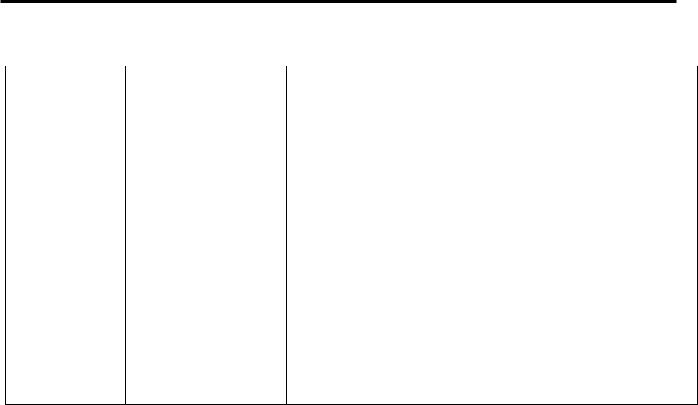
1. PRODUCT OVERVIEW |
ENGLISH VERSION EO1-33047 |
1.5 Options
1.5Options
2SWLRQ#1DPH# |
7\SH# |
8VDJH# |
6330GSL#3ULQW# |
%06$:37073+604005# |
7KLV#SULQW#KHDG#HQDEOHV#D#FRQYHUVLRQ#RI#D#5360GSL#SULQW#KHDG#RI#WKH# |
+HDG# |
|
%06$7700*645# PRGHO# LQWR# D# 6330GSL# SULQW# KHDG1# # 7KLV# RSWLRQ# LV# |
|
|
LQWHQGHG#IRU#XVH#ZKHQ#\RX#GHVLUH#WR#SULQW#.DQML#+&KLQHVH#FKDUDFWHUV,# |
|
|
RU#WR#REWDLQ#FOHDUHU#SULQW1## |
&XWWHU#PRGXOH# |
%06$53704005# |
$#FXWWHU#ZKLFK#FXWV#WKH#PHGLD#RQH#E\#RQH1##7KLV#PRGXOH#LV#VOLP#DQG# |
|
|
FRPSDFW#HQRXJK#WR#EH#ILWWHG#LQ#WKH#)URQW#&RYHU1## |
6WULS#PRGXOH# |
%06$<370+04005# |
7KLV#PRGXOH#SHHOV#RII#D#SULQWHG#ODEHO#IURP#WKH#EDFNLQJ#SDSHU#DW#WKH# |
|
# |
PHGLD#RXWOHW1##,W#LV#VOLP#DQG#FRPSDFW#HQRXJK#WR#EH#ILWWHG#LQ#WKH#)URQW# |
|
|
&RYHU1# |
6HULDO#,QWHUIDFH# |
%06$:3705604005# |
,QVWDOOLQJ#WKLV#3ERDUG#SURYLGHV#DQ#56565LQWHUIDFH#SRUW1# |
%RDUG# |
# |
|
:LUHOHVV#/$1# |
%06$:370:/$1040# |
,QVWDOOLQJ#WKLV#3ERDUG#DOORZV#D#FRPPXQLFDWLRQ#E\#ZLUHOHVV#/$11# |
%RDUG# |
# |
|
5),'#PRGXOH# |
%06$:3705),'084086# |
,QVWDOOLQJ#WKLV#PRGXOH#HQDEOHV#UHDG#DQG#ZULWH#RI#5),'#WDJV1# |
|
%06$:3705),'0840(8# |
$SSOLFDEOH#IUHTXHQF\#UDQJH#GLIIHUV#GHSHQGLQJ#RQ#WKH#PRGXOH#W\SHV=# |
|
%06$:3705),'0+4040# 84086=#8+)/#<350+]#WR#<5;0+]# |
|
|
|
840(8=#8+)/#;9<180+]# |
|
|
+4040=#+)/#461890+]# |
#
E1- 5
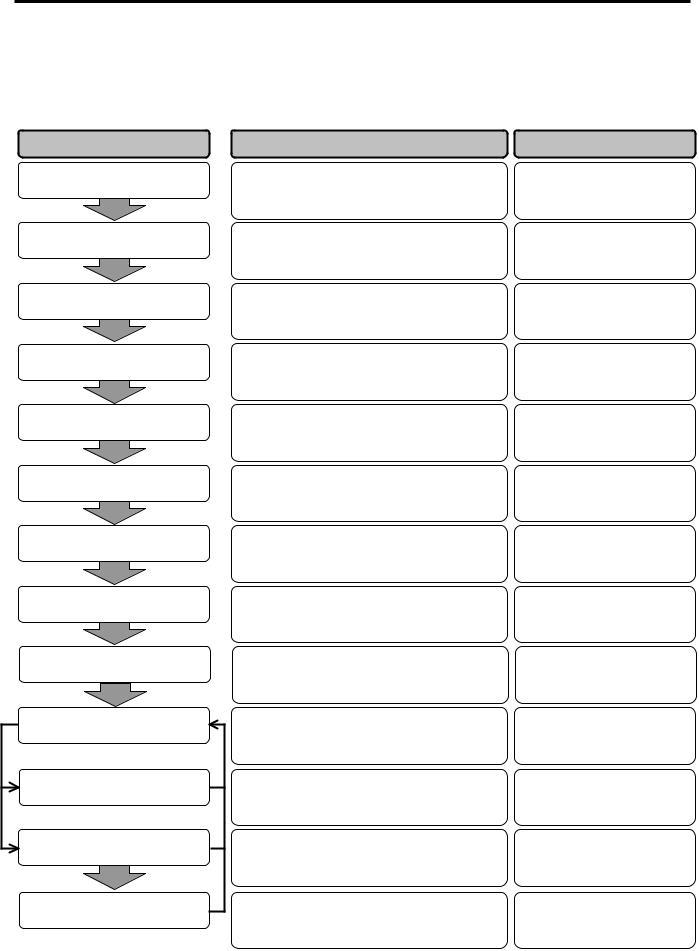
2. PRINTER SETUP
ENGLISH VERSION EO1-33047
2. PRINTER SETUP
2. PRINTER SETUP
This section outlines the procedures to setup your printer prior to its operation. The section includes precautions, loading media and ribbon, connecting cables, setting the operating environment of the printer, and performing an online print test.
Setup Flow
Installation
Connecting the power cord
Loading the media
Media sensor position alignment
Loading the ribbon
Connecting to a host computer
Turning the power ON
Setting the operating environment
Installing the printer driver
Print test
Position and Print Tone Fine
adjustment
Automatic threshold setting
Manual threshold setting
Procedure
After referring to the Safety Precautions in this manual, install the printer on a safe and stable location.
Connect a power cord to the power inlet of the printer, then, to an AC outlet.
Load a label stock or tag stock.
Adjust the position of feed gap sensor or black mark sensor according to the media to be used.
In case of thermal transfer printing, load the ribbon.
Connect the printer to a host computer or a network.
Turn on the printer power.
Set the printer parameters in the system mode.
If necessary, install the printer driver in your host computer.
Make a print test in your operating environment and check the print result.
If necessary, fine adjust the print start position, cut/strip position, print tone, etc.
If the print start position cannot be detected properly when pre-printed label is used, set the threshold automatically.
If the print start position cannot be detected properly even an automatic threshold setting is performing, manually set the threshold.
Reference
2.1Installation
2.2Connecting the Power Cord
2.3Loading the Media
2.3Loading the Media
2.4Loading the Ribbon
2.5Connecting the Printer to Your Host Computer
2.6Turning the Power ON
2.7Setting an Operating Environment
2.8Installing the Printer Drivers
2.9Print Test
2.10Position and Print Tone Fine Adjustment
2.11Threshold Setting
2.11 Threshold Setting
E2- 1

2. PRINTER SETUP
ENGLISH VERSION EO1-33047
2.2 Connecting the Power Cord
2.1 Installation
To insure the best operating environment, and to assure the safety of the operator and the equipment, please observe the following precautions.
•Operate the printer on a stable, level, operating surface in a location free from excessive humidity, high temperature, dust, vibration or direct sunlight.
•Keep your work environment static free. Static discharge can cause damage to delicate internal components.
•Make sure that the printer is connected to a clean source of AC Power and that no other high voltage devices that may cause line noise interference are connected to the same mains.
2.1.1Attaching the Printer Rear Support
NOTE:
The Printer Rear Support can be attached in either way of A or B. But A is more stable than B.
AB
2.2Connecting the Power Cord
CAUTION!
As a Power Cord is not supplied with the printer, please purchase an approved on that meets the safety standard of each country. (Refer to APPENDIX 3.)
•Assure that the printer is connected to the AC mains with a threeprong power cable that has the proper ground (earth) connection.
Attach the supplied Printer Rear Support to the bottom of the printer back with the SMW-4x8 screw, as shown in the picture below.
SMW-4x8
Printer Rear Support
1.Make sure that the printer Power Switch is in the OFF ({) position. Connect the Power Cord to the printer as shown in the figure below
Power Switch |
Power Cord |
2.Plug the other end of the Power Cord into a grounded outlet as shown in the figure below.
Power Cord |
Power Cord |
|
[Example of US Type] |
[Example of EU Type] |
E2- 2
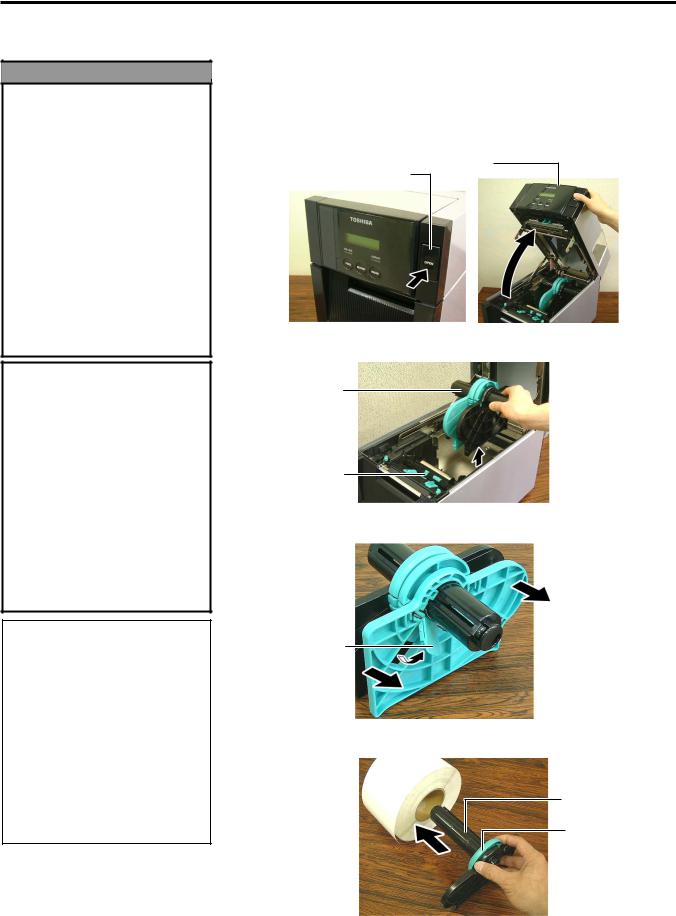
2. PRINTER SETUP
ENGLISH VERSION EO1-33047
2.3 Loading the Media
2.3 Loading the Media
WARNING!
1.Do not touch any moving parts. To reduce the risk of fingers, jewellery, clothing, etc., being drawn into the moving parts, be sure to load the media once the printer has stopped moving completely.
2.The Print Head becomes hot immediately after printing. Allow it to cool before loading the media.
3.To avoid injury, be careful not to trap your fingers while opening or closing the cover.
CAUTION!
1.Make sure that the Upper Sensor Ass’y is closed when taking out the Media Holder Ass’y. If the Upper Sensor Ass’y is opened, it may be damaged.
2.Be careful not to touch the Print Head Element when opening the Top Cover.
Failure to do this may cause missing dots by static electricity or other print quality problems.
NOTE:
1.As the Top Cover is heavy, be sure to support it with your hand when opening it. Failure to do this may cause the printer to fall over backward.
2.For the specification of available media, refer to
Section 7.1 Media.
3.When the inner core diameter of the media roll is 40 mm, remove the Spacers from the Media Holders.
The following procedure shows the steps to properly load the media into the printer so that it feeds straight and true through the printer.
Use the same procedure when replacing the media, also. The printer prints both labels and tags.
1.Press the Top Cover Release Button and gently open the Top Cover to its fully open position supporting it with your hand.
Top Cover
Top Cover Release Button
2. Take out the Media Holder Ass’y from the printer.
Media Holder
Ass’y
Upper Sensor
Ass’y
3. Raise the Release Lever and remove the Media Holder (Left).
 Media Holder (Left)
Media Holder (Left)
Release Lever
4. Insert the Media Shaft into the core of a media roll.
Media Shaft
Spacer
E2- 3
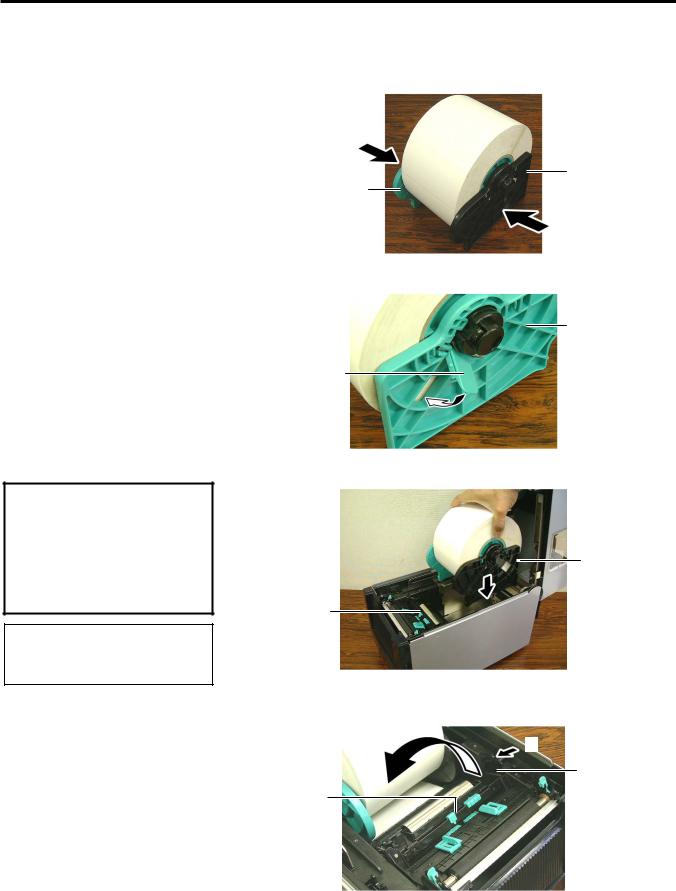
2. PRINTER SETUP
ENGLISH VERSION EO1-33047
2.3 Loading the Media
2.3Loading the Media (Cont.)
5.Put the Media Holder (Left) onto the Media Shaft. Push the Media Holder (Left) and the Media Holder (Right) against the media until the media is held firmly in place. This will automatically centre the media.
Media Holder (Right)
Media Holder (Left)
CAUTION!
Make sure that the Upper Sensor Ass’y is closed when placing the Media Holder Ass’y into the printer. If the Upper Sensor Ass’y is opened, it may be damaged.
NOTE:
Be careful of the orientation of the Media Holder Ass’y and the media.
6. Fold the Release Lever to lock the Media Holder (Left).
Media Holder (Left)
Release Lever
7. Place the Media Holder Ass’y into the printer.
Media Holder Ass’y
Upper Sensor
Ass’y
8.Slightly push the Upper Sensor Lever inside (c), and open the Upper Sensor Ass’y (d).
dc
Upper Sensor Lever
Upper Sensor
Ass’y
E2- 4
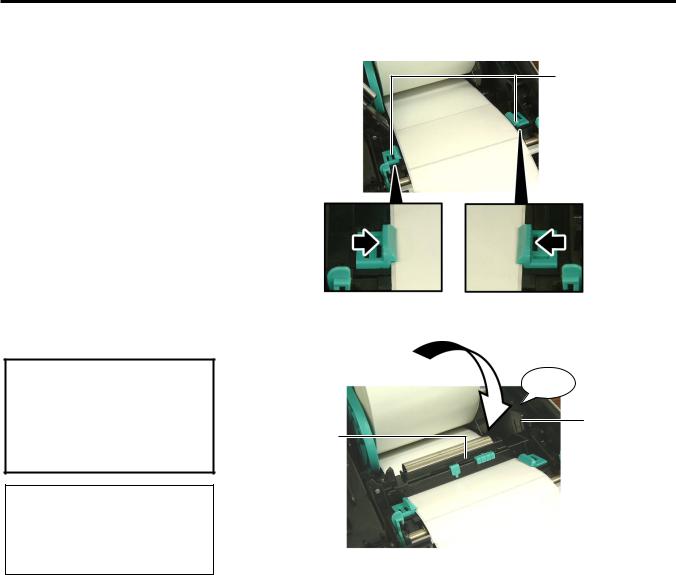
2. PRINTER SETUP
ENGLISH VERSION EO1-33047
2.3 Loading the Media
2.3Loading the Media (Cont.)
CAUTION!
Be sure to close the Upper Sensor Ass’y before closing the Top Cover. If the Upper Sensor Ass’y is opened, it may be damaged.
NOTE:
Make sure that the Upper Sensor Ass’y is locked. If it is unlocked, a paper jam or print failure may occur.
9. Pull the media out of the front of the printer, and adjust the Media Guides to the media width. This will automatically centre the media.
Media Guide
10.Lower the Upper Sensor Ass’y until the Upper Sensor Lever clicks into position.
Click
Upper Sensor
Upper Sensor Lever
Ass’y
E2- 5
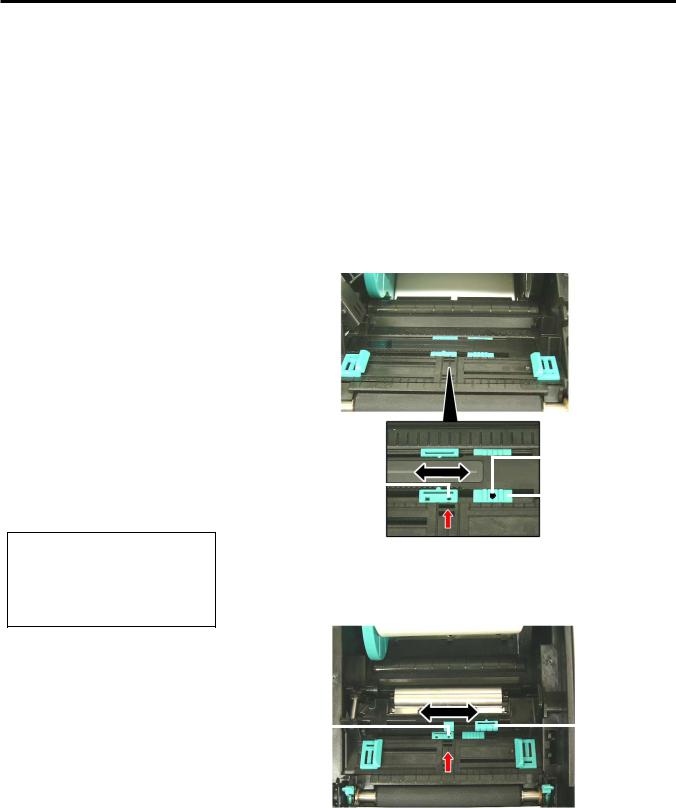
2. PRINTER SETUP
ENGLISH VERSION EO1-33047
2.3 Loading the Media
2.3Loading the Media (Cont.)
11.After loading the media, it may be necessary to set the position of the Media Sensor used to detect the print start position for label or tag printing.
Setting the Feed Gap Sensor position
When using a label stock without black marks, the Feed Gap Sensor is used to detect a print start position.
(1)Push the Upper Sensor Lever inside and open the Upper Sensor Ass’y.
(2)Slide the Lower Sensor Tab with your finger to move the Feed Gap Sensor so that the Feed Gap Sensor is positioned at the centre of the labels. ( { indicates the position of the Feed Gap Sensor).
It may be easier to move the Lower Sensor Tab when using a pen with its tip inserted into the pinhole of the tab.
NOTE:
Be sure to align the Upper Feed Gap Sensor with the Lower Feed Gap Sensor. Failure to do this cause a paper jam error.
Feed Gap |
|
|
|
|
|
Pinhole |
|
|
|
|
|
||
|
|
|
|
|
Lower Sensor Tab |
|
|
|
|
|
|
||
Sensor |
|
|
|
|
||
|
|
|
|
|||
(3)Lower the Upper Sensor Ass’y until the Upper Sensor Lever clicks into position.
(4)Slide the Upper Sensor Tab to move the Feed Gap Sensor so that it aligns with the lower Feed Gap Sensor.
Feed Gap |
|
|
|
|
|
Upper Sensor |
Sensor |
|
|
|
|
Tab |
|
|
|
|
||||
|
|
|
|
|
|
|
E2- 6

2. PRINTER SETUP
ENGLISH VERSION EO1-33047
2.3 Loading the Media
2.3Loading the Media (Cont.)
NOTES:
1.Be sure to set the Black Mark Sensor to detect the centre of the black mark, otherwise a paper jam or no paper error may occur.
2.After adjusting the Black Mark Sensor position, align the Upper Feed Gap Sensor with the Lower Feed Gap Sensor. This is because a paper end is detected by the Feed Gap Sensor.
Setting the Black Mark Sensor position
When using media with black marks, the Black Mark Sensor is used to detect a print start position.
(1)Push the Upper Sensor Lever inside and open the Upper Sensor Ass’y.
(2)Check the reverse side of the media for the black mark position.
(3)Slide the Lower Sensor Tab to move the Black Mark Sensor so that it is in line with the centre of the black mark on the media.
( indicates the position of the Black Mark Sensor).
It may be easier to move the Lower Sensor Tab when using a pen with its tip inserted into the pinhole of the tab.
Pinhole
Black Mark
Sensor 
 Lower Sensor
Lower Sensor
Tab
(4)Lower the Upper Sensor Ass’y until the Upper Sensor Lever clicks in position.
E2- 7
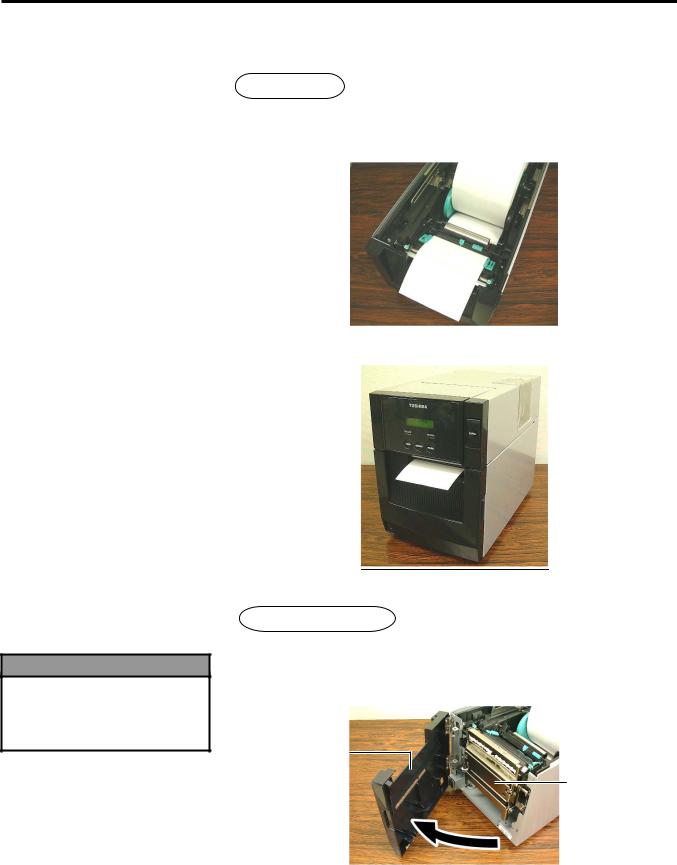
2. PRINTER SETUP
ENGLISH VERSION EO1-33047
2.3 Loading the Media
2.3Loading the Media (Cont.)
12.There are three issue modes available on this printer. How to set the media for each mode is provided below.
Batch mode
In the batch mode, the media is continuously printed and fed until the number of labels/tags specified in the issue command have been printed.
(1) Pull the top edge of the media past the Platen.
(2) Close the Top Cover until it clicks.
WARNING!
Be careful that your fingers, jewellery, clothing, etc., are not draw into the rollers of the Strip Unit.
Strip mode (Option)
When the optional Strip Module is fitted, a label is automatically removed from the backing paper at the Strip Plate as each label is printed.
(1)Open the Front Cover holding its right side.
Front Cover
Strip Unit
E2- 8
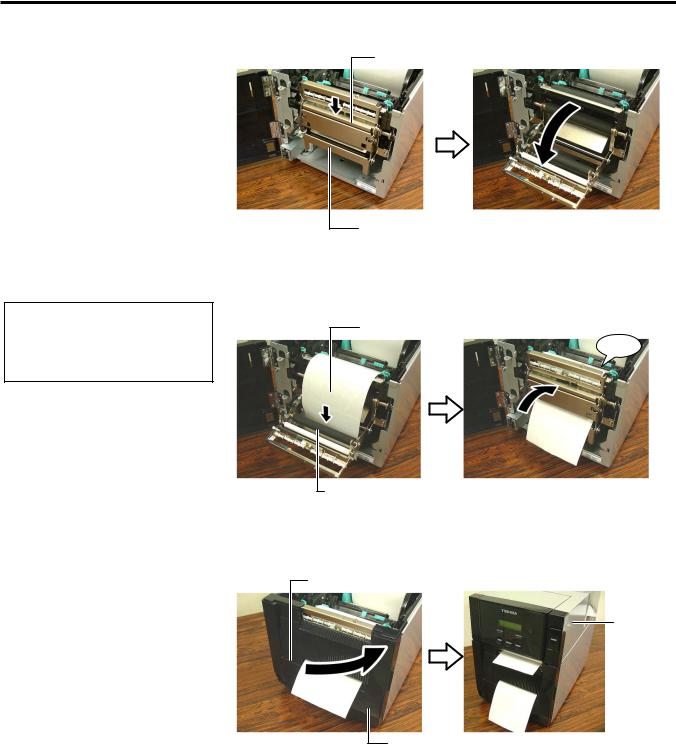
2. PRINTER SETUP
ENGLISH VERSION EO1-33047
2.3 Loading the Media
2.3Loading the Media (Cont.)
NOTE:
Be sure to close the Strip Unit completely. Failure to do this may cause a paper jam.
(2) Press down the Release Bar to open the Strip Unit.
Release Bar
Strip Unit
(3)Remove enough labels from the leading edge of the media to leave 300mm of backing paper free.
(4)Pass the backing paper through the opening under the Backing Paper Feed Roller. Then, close the Strip Unit until it clicks.
Backing Paper
Click
Backing Paper Feed Roller
(5)Insert the leading edge of the backing paper into the slot of the Front Cover.
(6)Close the Front Cover and the Top Cover.
Slot
Top Cover
Front Cover
E2- 9
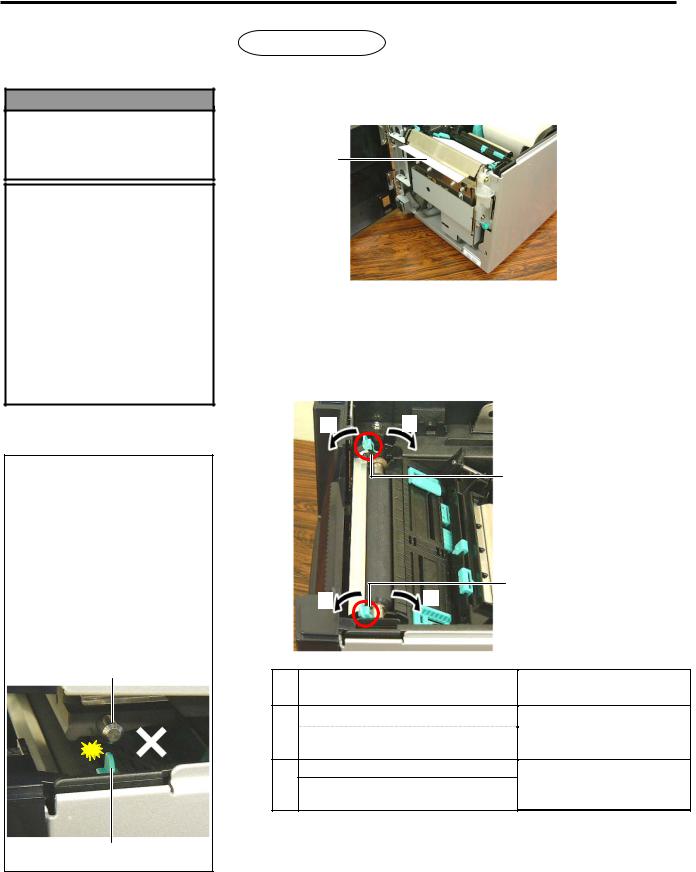
2. PRINTER SETUP
ENGLISH VERSION EO1-33047
2.3 Loading the Media
2.3Loading the Media (Cont.)
WARNING!
The cutter is sharp, so care must be taken not to injure your fingers when handling the cutter.
CAUTION!
1.When using a label stock, be sure to cut the gaps. Cutting labels will cause the glue to stick to the cutter, which may affect the cutter quality and shorten the cutter life.
2.Use of tag paper which thickness exceeds specified value may affect the cutter life. For the specification of the media, refer to Section 7.1 Media.
NOTES:
1.Be sure to set both Head Pressure Adjustment Levers in the same direction. Failure to do this may cause blurred printing.
2.Do not leave the Head Pressure Adjustment Levers positioned at the middle. When closing the Top Cover, they block the Print Head Positioning Shaft, and the Top Cover cannot be closed.
Print Head Positioning Shaft
Head Pressure Adjust Lever
Cut mode (Option)
When the optional Cutter Module is fitted, the media is automatically cut.
Insert the leading edge of the media into the Media Outlet of the Cutter Module.
Media
13.Change the print head pressure according to the thickness of the media to be used, by using the Head Pressure Adjust Lever.
cd
Head Pressure
Adjustment Lever
|
|
Head Pressure |
c |
d |
Adjustment Lever |
Media type or thickness
Label or Thin media
cIf a clear print cannot be obtained, change the position to d.
Tag paper or Thick paper
dIf a clear print cannot be obtained, change the position to c.
Head Pressure
Adjustment Lever
Move the levers toward the front of the printer.
Move the levers toward the back of the printer.
14.If the loaded media is direct thermal media (with a chemically treated surface), the media loading procedure is now completed. Close the Top Cover.
If the media is normal media, it is also necessary to load a ribbon. Refer to Section 2.4 Loading the Ribbon.
E2-10

2. PRINTER SETUP
ENGLISH VERSION EO1-33047
2.4 Loading the Ribbon
2.4 Loading the Ribbon
WARNING!
1.Do not touch any moving parts. To reduce the risk of fingers, jewellery, clothing, etc., being drawn into the moving parts, be sure to load the ribbon once the printer has stopped moving completely.
2.The print head becomes hot immediately after printing. Allow it to cool before loading the ribbon.
3.To avoid injury, be careful not to trap your fingers while opening or closing the cover.
CAUTION!
Be careful not touch the Print Head Element when opening the Top Cover. Failure to do this may cause missing dots by static electricity or other print quality problems.
NOTE:
When replacing the ribbon, leave the printer power on. Then, press the [RESTART] key to restart an operation.
There are two types of media available for printing on: these are thermal transfer media (normal media) and direct thermal media (with a chemically treated surface). DO NOT LOAD a ribbon when using a direct thermal media.
1.Press the Top Cover Release Button and gently open the Top Cover to its fully open position supporting it with your hand.
Top Cover
Top Cover Release Button
2.Fit the core of the ribbon supply roll into the Ribbon Holders (Supply side), aligning the notch of the ribbon core with the protrusion of the Ribbon Stopper.
Ribbon Holder (Supply side)
|
|
|
|
|
|
|
|
Ribbon Supply Roll |
|
Notch |
|
|
|||
Fit the protrusion into the notch.
E2-11
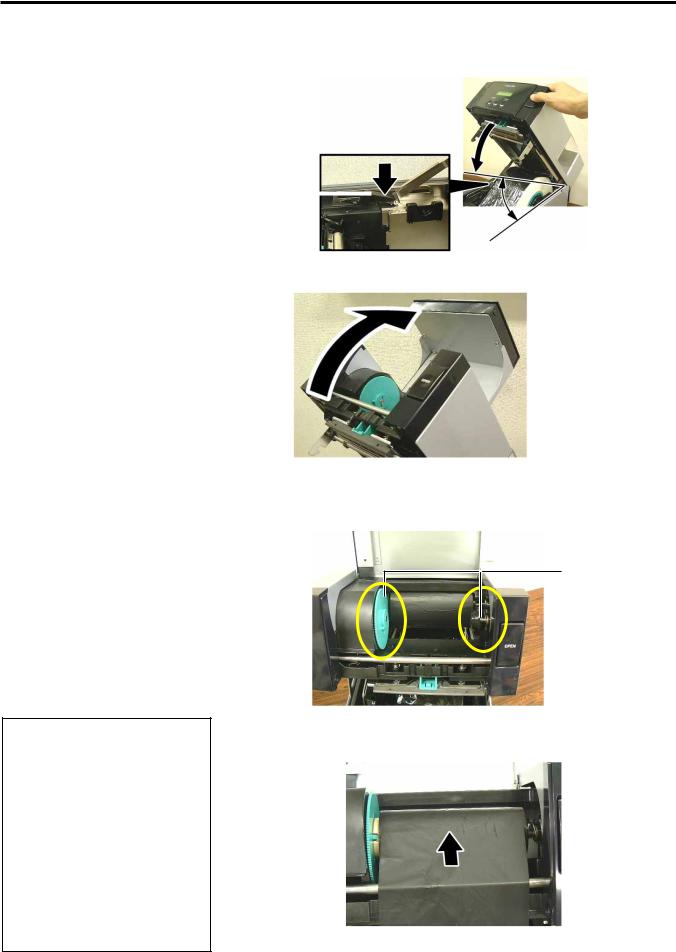
2. PRINTER SETUP |
ENGLISH VERSION EO1-33047 |
2.4 Loading the Ribbon
2.4Loading the Ribbon (Cont.)
3.# /RZHU#WKH#7RS#&RYHU#WR#LWV#78°#DQJOH#RSHQ#SRVLWLRQ1##:KLOH#SXVKLQJ##
#WKH#7RS#&RYHU#6WRSSHU/#UDLVH#WKH#7RS#&RYHU#DJDLQ1##7KLV#ZLOO#IL[#WKH# 7RS#&RYHU1##
127(6=#
41# %H#VXUH#WR#UHPRYH#DQ\#VODFN#LQ#
WKH#ULEERQ#ZKHQ#SULQWLQJ1## 3ULQWLQJ#ZLWK#D#ZULQNOHG#ULEERQ# ZLOO#ORZHU#WKH#SULQW#TXDOLW\1##
51# :KHQ#D#ULEERQ#HQG#LV#GHWHFWHG/# ³5,%%21#(5525´#PHVVDJH# ZLOO#DSSHDU#RQ#WKH#GLVSOD\#DQG# WKH#(5525#/('#ZLOO#LOOXPLQDWH1#
61# :KHQ#GLVSRVLQJ#RI#WKH#ULEERQV/# SOHDVH#IROORZ#WKH#ORFDO#UXOHV1##
71# )RU#WKH#VSHFLILFDWLRQ#RI# DYDLODEOH#ULEERQ/#UHIHU#WR#
6HFWLRQ#:15#5LEERQ1#
 Top Cover
Top Cover
Top Cover |
|
|
|
|
|
||
Stopper |
° |
||
|
|
|
45 |
#
#
4.# 2SHQ#WKH#5LEERQ#&RYHU1##
 Ribbon Cover
Ribbon Cover
#
#
5.# )LW#WKH#ULEERQ#WDNH0XS#FRUH#LQWR#WKH#5LEERQ#+ROGHU#+7DNH0XS#VLGH,/# DOLJQLQJ#WKH#QRWFK#RI#WKH#ULEERQ#FRUH#ZLWK#WKH#SURWUXVLRQ#RI#WKH#5LEERQ# 6WRSSHU1#
Ribbon Holder (Take-up side)
6.7XUQ WKH#ULEERQ#WDNH0XS#FRUH#LQ#WKH#GLUHFWLRQ#LQGLFDWHG#E\#WKH#DUURZ#WR# UHPRYH#DQ\#VODFN1
#
E2-12
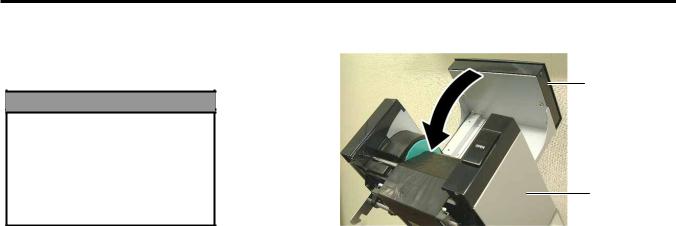
2. PRINTER SETUP |
ENGLISH VERSION EO1-33047 |
2.4 Loading the Ribbon
2.4 Loading the Ribbon 7. &ORVH#WKH#5LEERQ#&RYHU#XQWLO#LW#FOLFNV1
(Cont.)
WARNING!
Be sure to close the Ribbon Cover before closing the Top Cover. It is dangerous to close the Top Cover with the Ribbon Cover opened, as the Ribbon Cover slams shut.
#
8.# *HQWO\#FORVH#WKH#7RS#&RYHU#XQWLO#LW#FOLFNV1##
Ribbon Cover
Top Cover
E2-13
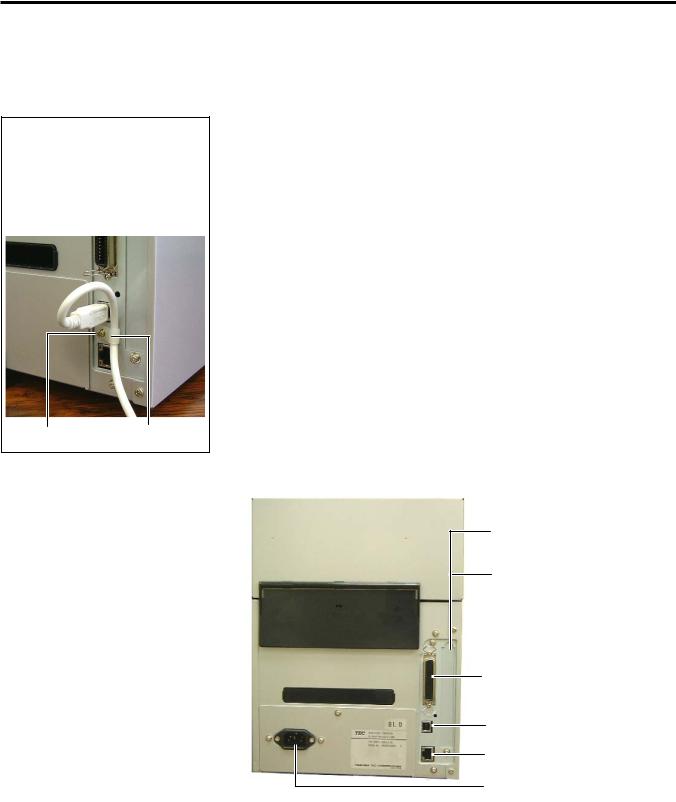
2. PRINTER SETUP
ENGLISH VERSION EO1-33047
2.5 Connecting the Printer to Your Host Computer
2.5Connecting the Printer to Your Host Computer
NOTE:
When using the USB interface, fix the USB Interface Cable to the printer back with the supplied Cable Clamp and the SMW-3x8 screw.
SMW-3x8 |
Cable Clamp |
The following paragraphs outline how to connect your host computer to the printer, and will also show how to make cable connections to other devices. Depending on the system configuration you use to print labels, there are 5 possibilities for connecting the printer to your host computer. These are:
•A parallel cable connection between the printer’s standard parallel connector and your host computer’s parallel port (LPT).
•An Ethernet connection using the standard LAN board.
•A USB cable connection between the printer’s standard USB connector and your host computer’s USB port. (Conforming to USB 2.0 Full Speed)
•A serial cable connection between the printer’s optional RS-232C serial connector and one of your host computer’s COM ports. <Option>
•Wireless LAN using an optional Wireless LAN board. <Option>
For details of each interface, refer to APPENDIX 2.
After connecting the necessary interface cables, set an operating environment of the printer. Refer to Section 2.7.2 Parameter Setting.
The diagram below shows all the possible cable connections to the current version of the printer.
Serial Interface Connector (Option)
Wireless LAN Interface
Board (Option)
Parallel Interface Connector (Centronics)
USB Interface Connector
LAN Interface Connector
Power Inlet
E2-14
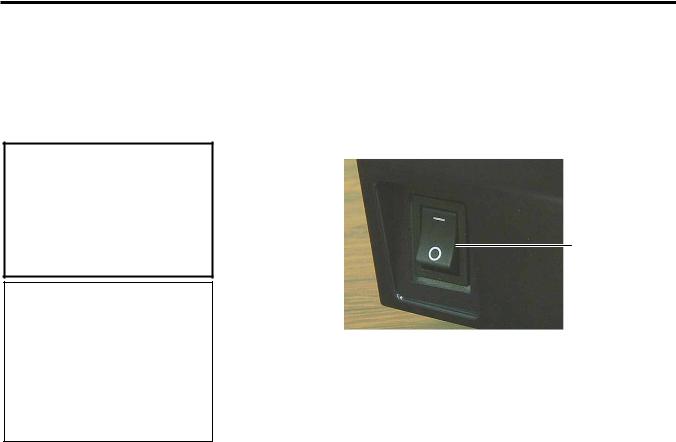
2. PRINTER SETUP |
ENGLISH VERSION EO1-33047 |
2.6 Turning the Printer ON
2.6Turning the Printer ON#
#
#
#
# |
CAUTION! |
|
# |
||
|
||
#Use the power switch to turn the |
||
#printer On/Off. Plugging or |
||
#unplugging the Power Cord to |
||
#turn the printer On/Off may |
||
#cause fire, an electric shock, or |
||
##damage to the printer. |
||
#127(6=#
#41# ,I#D#PHVVDJH#RWKHU#WKDQ#21# |
|
# |
/,1(#DSSHDUV#RQ#WKH#GLVSOD\#RU# |
# |
WKH#(5525#/('#+5HG,#LV# |
# |
LOOXPLQDWHG/#JR#WR#6HFWLRQ#814/# |
# |
(UURU#0HVVDJHV1# |
#51# 7R#WXUQ#2))#WKH#SULQWHU#SRZHU# |
|
# |
WXUQ#WKH#3RZHU#6ZLWFK#WR#WKH# |
# |
³{´#VLGH#SRVLWLRQ1# |
# |
|
# |
|
# |
|
# |
|
# |
|
# |
|
# |
|
# |
|
# |
|
# |
|
# |
|
# |
|
# |
|
# |
|
# |
|
# |
|
:KHQ#WKH#SULQWHU#LV#FRQQHFWHG#WR#\RXU#KRVW#FRPSXWHU#LW#LV#JRRG#SUDFWLFH#WR# WXUQ#WKH#SULQWHU#21#EHIRUH#WXUQLQJ#RQ#\RXU#KRVW#FRPSXWHU#DQG#WXUQ#2))# \RXU#KRVW#FRPSXWHU#EHIRUH#WXUQLQJ#RII#WKH#SULQWHU1#
#
#
1.# 7R#WXUQ#21#WKH#SULQWHU#SRZHU/#SUHVV#WKH#3RZHU#6ZLWFK#DV#VKRZQ#LQ#WKH# GLDJUDP#EHORZ1##1RWH#WKDW#+#|#,#LV#WKH#SRZHU#21#VLGH#RI#WKH#VZLWFK1#
Power Switch
#
#
2.# &KHFN#WKDW#WKH#21#/,1(#PHVVDJH#DSSHDUV#LQ#WKH#/&'#0HVVDJH# 'LVSOD\#DQG#WKDW#WKH#21#/,1(#/('#+*UHHQ,#LV#LOOXPLQDWHG1##
#
#
E2-15
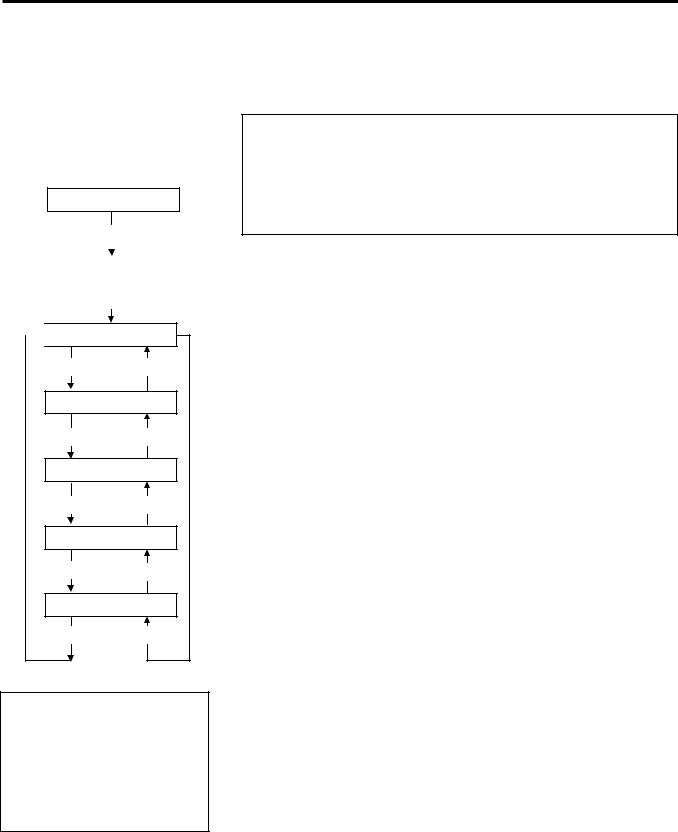
2. PRINTER SETUP |
ENGLISH VERSION EO1-33047 |
2.7 Setting an Operating Environment
2.7Setting an Operating Environment
#
#
#
#
#
ON LINE
#
# |
|
[PAUSE] |
|
|
# |
|
|
|
|
|
|
|
|
|
# |
PAUSE |
|||
|
|
|
|
|
Hold down [RESTART] for 3 sec.

 <1>RESET
<1>RESET
[FEED] [RESTART]
<2>PARAMETER SET
[FEED] [RESTART]
<3>ADJUST SET
[FEED] [RESTART]
<4>DUMP MODE
[FEED] [RESTART]
<5>EXPAND MODE
[FEED] [RESTART]
127(6=#
41# 6\VWHP#0RGH#PHQXV#FDQ#EH# VHOHFWHG#ZLWK#WKH#>5(67$57@#
RU#>)(('@#NH\1#
51# 7R#HQWHU#HDFK#RI#WKH#DERYH# 6\VWHP#0RGH#PHQXV/#SUHVV#WKH# >3$86(@#NH\#ZKHQ#WKH#PHQX#LV# GLVSOD\HG1#
'HSHQGLQJ# RQ# WKH# VHWWLQJV# RI# \RXU# KRVW# FRPSXWHU# RU# DQ# LQWHUIDFH# WR# EH# XVHG/#LW#PD\#EH#QHFHVVDU\#WR#FKDQJH#WKH#SULQWHU#SDUDPHWHU#VHWWLQJV1#
#
)ROORZ# WKH# SURFHGXUHV# GHVFULEHG# EHORZ# WR# FKDQJH# WKH# SULQWHU# SDUDPHWHU# VHWWLQJV#LQ#WKH#6\VWHP#0RGH#WR#FRUUHVSRQG#WR#\RXU#HQYLURQPHQW1##
#
#
#
#
#
#
#
#
#
#
7KH#6\VWHP#0RGH#FRQVLVWV#RI#WKH#IROORZLQJ#PHQXV1##
#
#
?4!5(6(7# 7KLV#PHQX#LV#XVHG#WR#FOHDU#SULQW#GDWD#VHQW#IURP#D# 3DQG#UHWXUQ#WKH#SULQWHU#WR#DQ#LGOH#VWDWH1##
5HIHU#WR#6HFWLRQ#616#5HVHW1#
#
#
?5!3$5$0(7(5#6(7# 7KLV#PHQX#LV#XVHG#WR#VHW#WKH#SULQWHU#SDUDPHWHUV1#
#
#
#
?6!$'-867#6(7# 7KLV#PHQX#LV#XVHG#WR#PDNH#D#ILQH#DGMXVWPHQW#RI#D# SULQW#VWDUW#SRVLWLRQ/#FXW#SRVLWLRQ/#HWF1#
5HIHU#WR#6HFWLRQ#5143#3RVLWLRQ#DQG#3ULQW#7RQH# )LQH#$GMXVWPHQW1##
?7!'803#02'(# 7KLV#PHQX#LV#XVHG#WR#SULQW#WKH#GDWD#LQ#WKH#UHFHLYH# EXIIHU#IRU#GHEXJ1#
#
#
?8!(;3$1'#02'(# 7KLV#PHQX#LV#XVHG#WR#VWDUW#WKH#SURJUDP#IRU#
%$6,PRGH1#
5HIHU#WR#WKH#%06$77#6HULHV#.H\#2SHUDWLRQ#
6SHFLILFDWLRQ#VWRUHG#LQ#WKH#&'05201##
#
#
#
E2-16
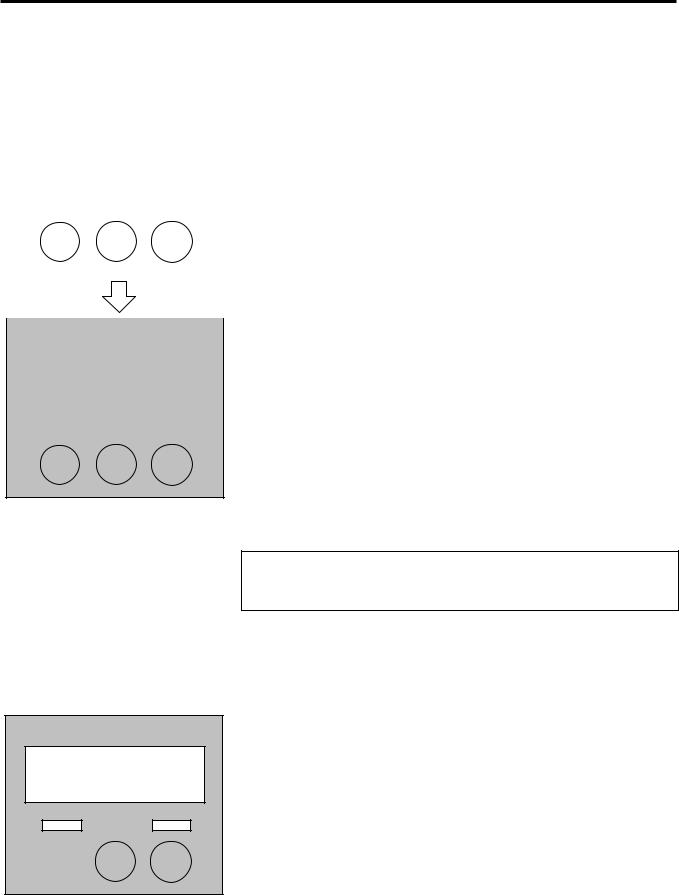
2. PRINTER SETUP |
ENGLISH VERSION EO1-33047 |
2.7 Setting an Operating Environment
2.7.1How to Enter the System Mode
# |
|
|
|
|
|
|
|
|
|
|
|
|
|
|
|
|
|
# |
|
|
|
|
|
|
|
|
# |
|
ONLINE |
|
|
|
|
||
# |
|
B-SA4T |
V1.0 |
|
||||
# |
|
|
||||||
# |
|
|
|
|
|
|
|
|
|
|
|
|
|
|
|
|
|
# |
|
|
|
|
|
|
|
|
|
|
|
|
|
|
|
|
|
# |
|
|
|
|
|
P |
||
# |
|
|
|
|
|
|||
# |
|
|
|
|
|
|
|
|
# |
|
|
|
|
|
|
|
|
|
|
|
|
|
|
|
|
|
# |
|
|
|
|
|
|
|
|
# |
|
|
|
|
|
|
|
|
# |
|
|
|
|
|
|
|
|
|
|
|
|
|
|
|
|
|
|
|
|
|
|
|
|
||
|
|
PAUSE |
|
|
|
|
||
|
|
B-SA4T |
V1.0 |
|
||||
|
|
|
|
|
|
|
|
|
|
|
|
|
|
|
|
|
|
|
|
|
|
|
|
|
|
|
R
2.7.2 Parameter Setting
#
#
#
#<2>PARAMETER SET
 P
P
7KLV#VHFWLRQ#GHVFULEHV#KRZ#WR#HQWHU#WKH#6\VWHP#0RGH1#
#
#
1.# 7XUQ#RQ#WKH#SULQWHU#DQG#FRQILUP#WKDW#³21/,1(´#DSSHDUV#RQ#WKH#/&'# 0HVVDJH#'LVSOD\1#
#
#
#
#
#
#
#
2.# 3UHVV#WKH#[PAUSE]#NH\#WR#SDXVH#WKH#SULQWHU1#
#
#
#
#
#
#
#
#
#
#
#
#
#
3.# +ROG#GRZQ#WKH#[RESTART]#NH\#IRU#WKUHH#VHFRQGV#XQWLO#³?4!5(6(7´# LV#GLVSOD\HG1##
#
#
4.# 3UHVV#WKH#[FEED]#NH\/#DQG#³?5!3$5$0(7(5#6(7´#DSSHDUV#RQ#WKH# /&'#0HVVDJH#'LVSOD\1##
# |
127(=# |
# |
#,I#WKH#[PAUSE]#NH\#LV#SUHVVHG#ZLWK#³?4!5(6(7´#EHLQJ#GLVSOD\HG/#WKH#
#SULQWHU#ZLOO#WXUQ#WR#DQ#LGOH#VWDWH#DQG#WKH#PHVVDJH#ZLOO#FKDQJH#WR#³21/,1(´1#
#
#
#
,Q#WKLV#VHFWLRQ/#KRZ#WR#VHOHFW#D#ODQJXDJH#DQG#KRZ#WR#VHW#WKH# FRPPXQLFDWLRQ#SDUDPHWHUV#DUH#GHVFULEHG1##:KHQ#IXUWKHU#LQIRUPDWLRQ#LV#
UHTXLUHG/#UHIHU#WR#WKH#%06$77#6HULHV#.H\#2SHUDWLRQ#6SHFLILFDWLRQ1##
#
#
#
#
#
#
#
:KLOH# ³?5!3$5$0(7(5# 6(7´# LV# GLVSOD\HG# RQ# WKH# /&'# 0HVVDJH# 'LVSOD\/#SUHVV#WKH#[PAUSE]#NH\#WR#HQWHU#WKH#3DUDPHWHU#6HWWLQJ#0RGH1##
#
E2-17
